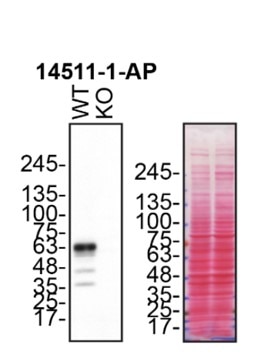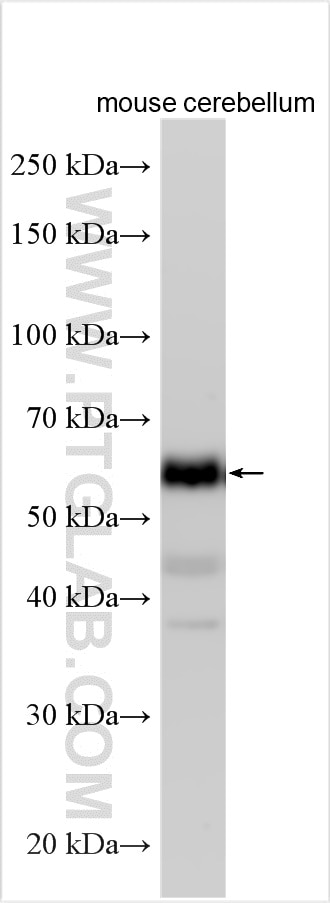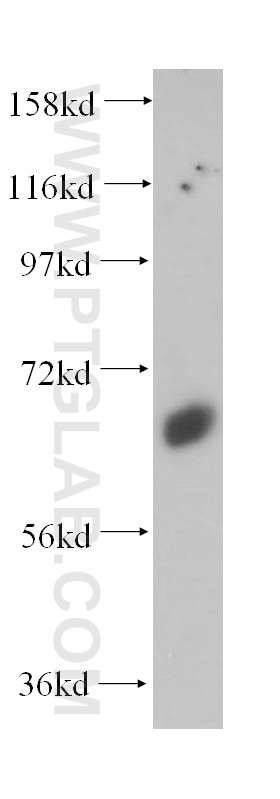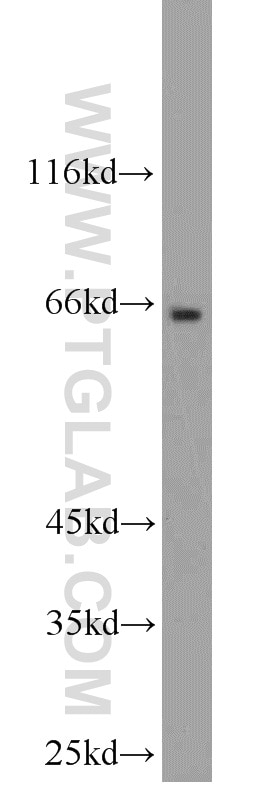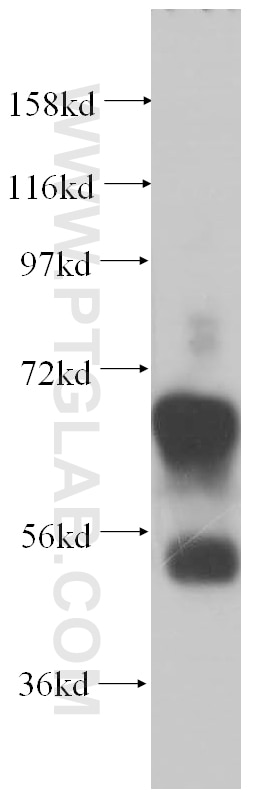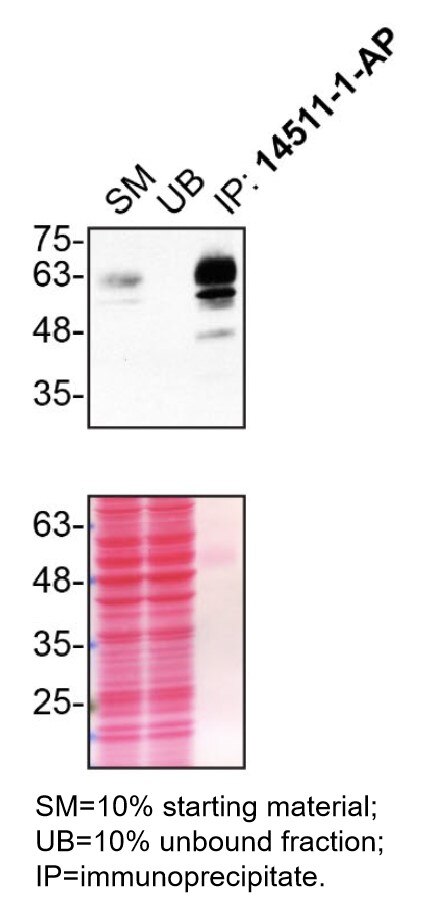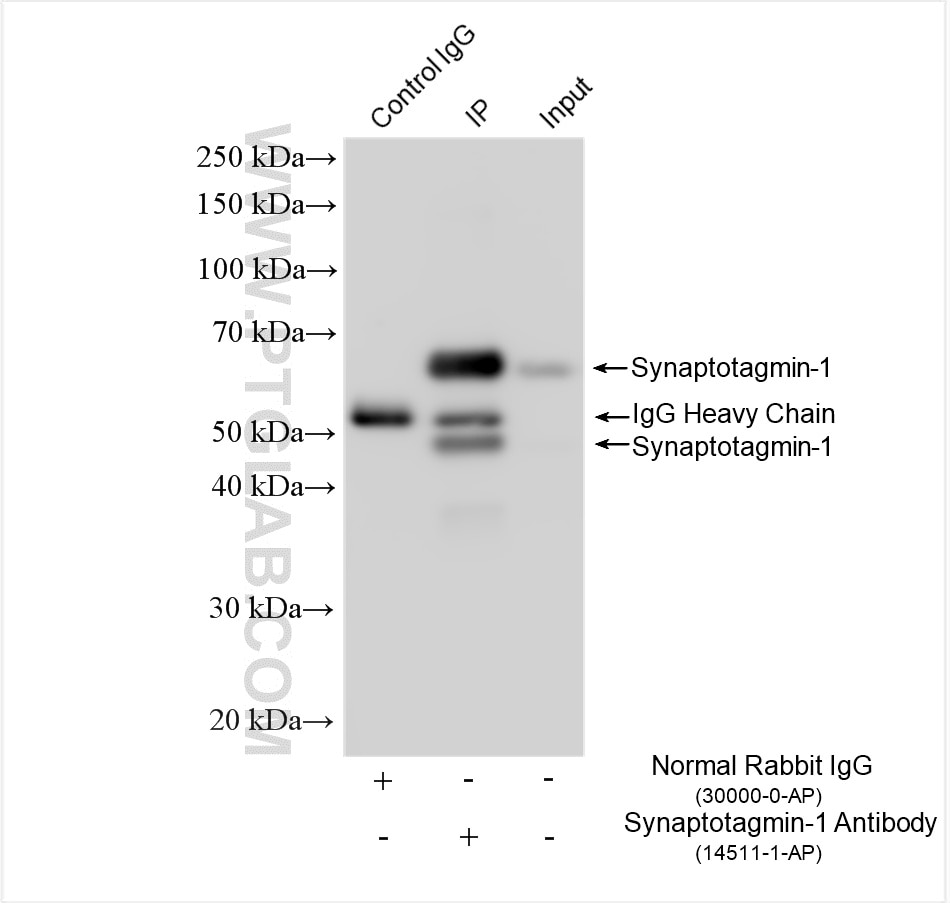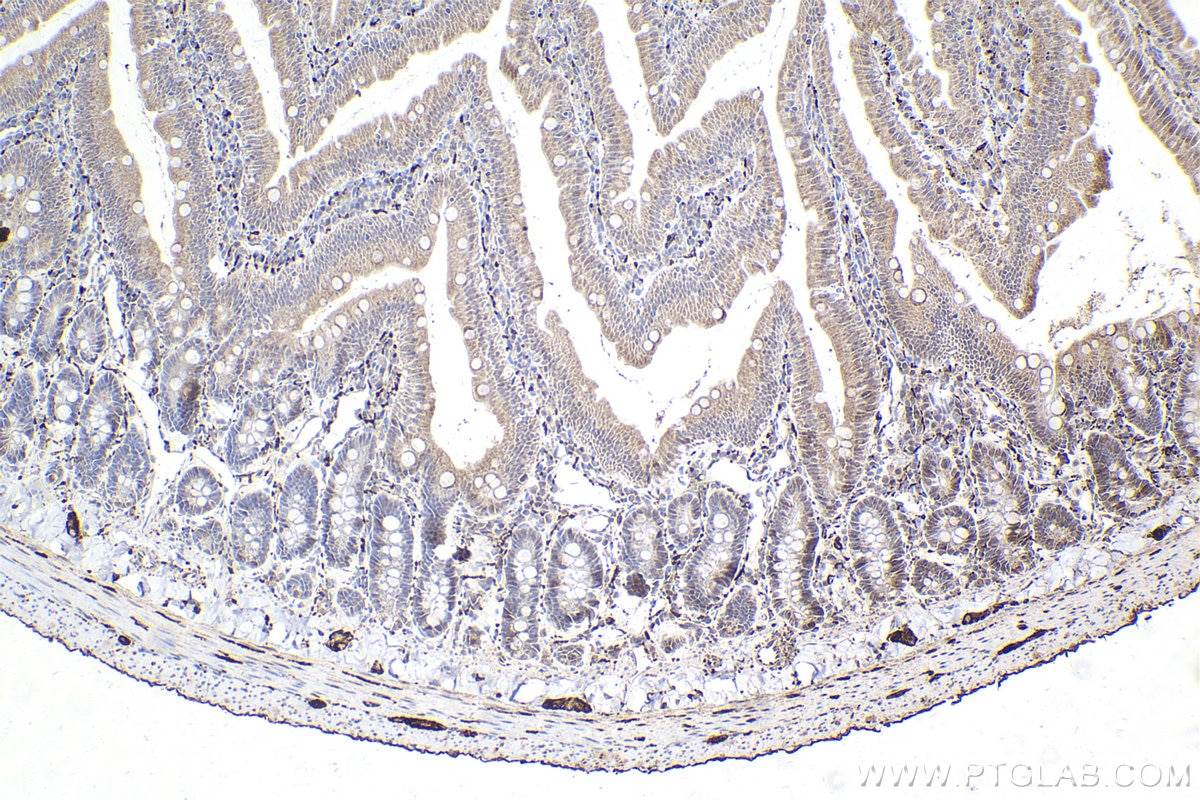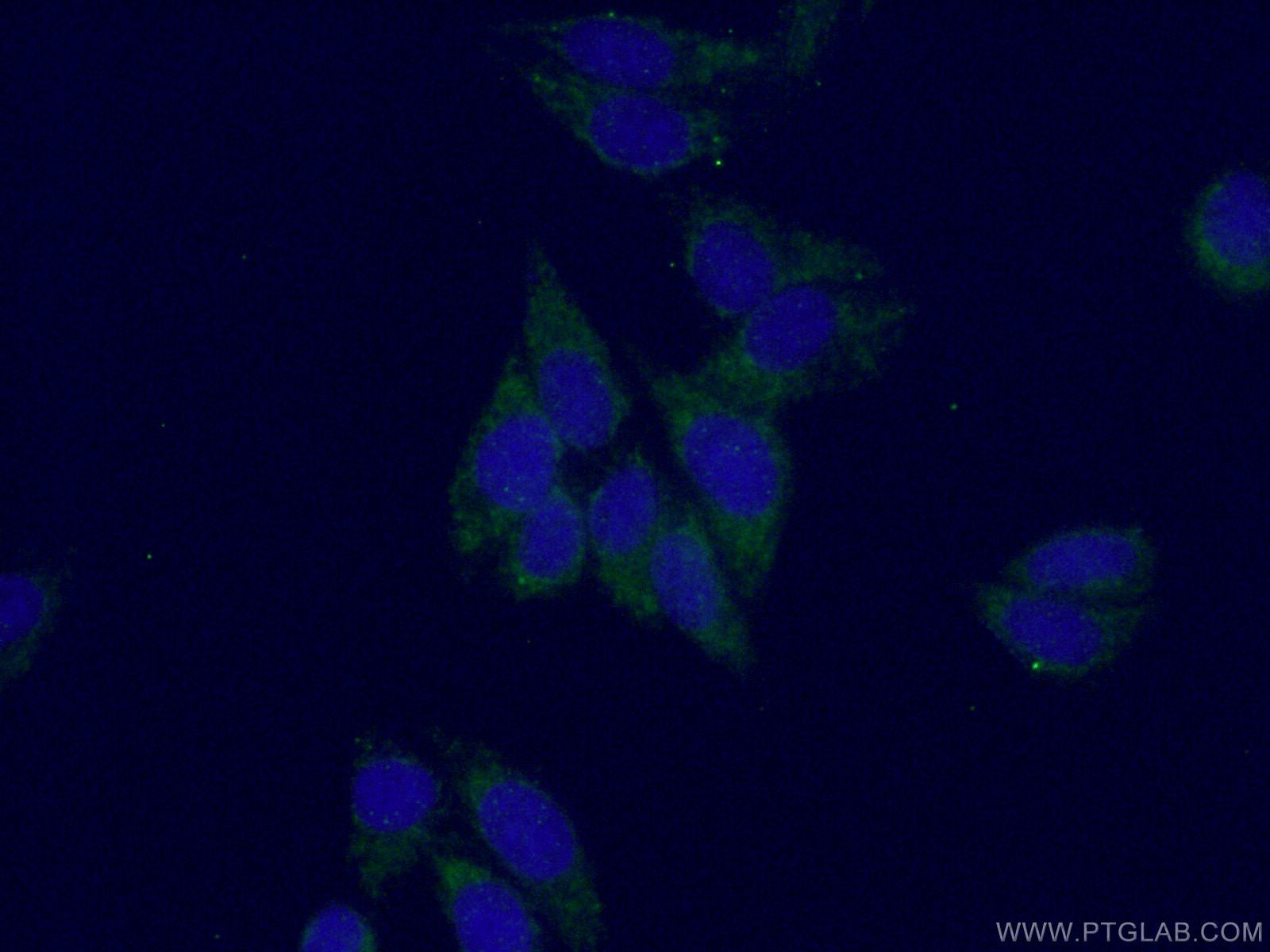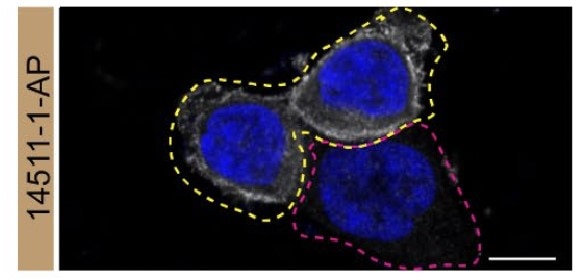Tested Applications
| Positive WB detected in | mouse cerebellum tissue, HCT 116 cells, mouse testis tissue, human liver tissue, Y79 cells |
| Positive IP detected in | mouse cerebellum tissue, HCT 116 cells |
| Positive IHC detected in | rat small intestine tissue Note: suggested antigen retrieval with TE buffer pH 9.0; (*) Alternatively, antigen retrieval may be performed with citrate buffer pH 6.0 |
| Positive IF/ICC detected in | HepG2 cells, HCT 116 cells |
Recommended dilution
| Application | Dilution |
|---|---|
| Western Blot (WB) | WB : 1:4000-1:20000 |
| Immunoprecipitation (IP) | IP : 0.5-4.0 ug for 1.0-3.0 mg of total protein lysate |
| Immunohistochemistry (IHC) | IHC : 1:500-1:2000 |
| Immunofluorescence (IF)/ICC | IF/ICC : 1:50-1:500 |
| It is recommended that this reagent should be titrated in each testing system to obtain optimal results. | |
| Sample-dependent, Check data in validation data gallery. | |
Published Applications
| KD/KO | See 1 publications below |
| WB | See 18 publications below |
| IHC | See 3 publications below |
| IF | See 5 publications below |
| IP | See 1 publications below |
Product Information
14511-1-AP targets Synaptotagmin-1 in WB, IHC, IF/ICC, IP, ELISA applications and shows reactivity with human, mouse samples.
| Tested Reactivity | human, mouse |
| Cited Reactivity | human, mouse, rat |
| Host / Isotype | Rabbit / IgG |
| Class | Polyclonal |
| Type | Antibody |
| Immunogen |
CatNo: Ag5970 Product name: Recombinant human SYT1 protein Source: e coli.-derived, PGEX-4T Tag: GST Domain: 97-422 aa of BC058917 Sequence: GGKNAINMKDVKDLGKTMKDQALKDDDAETGLTDGEEKEEPKEEEKLGKLQYSLDYDFQNNQLLVGIIQAAELPALDMGGTSDPYVKVFLLPDKKKKFETKVHRKTLNPVFNEQFTFKVPYSELGGKTLVMAVYDFDRFSKHDIIGEFKVPMNTVDFGHVTEEWRDLQSAEKEEQEKLGDICFSLRYVPTAGKLTVVILEAKNLKKMDVGGLSDPYVKIHLMQNGKRLKKKKTTIKKNTLNPYYNESFSFEVPFEQIQKVQVVVTVLDYDKIGKNDAIGKVFVGYNSTGAELRHWSDMLANPRRPIAQWHTLQVEEEVDAMLAVKK Predict reactive species |
| Full Name | synaptotagmin I |
| Calculated Molecular Weight | 48 kDa |
| Observed Molecular Weight | 65 kDa, 47 kDa |
| GenBank Accession Number | BC058917 |
| Gene Symbol | Synaptotagmin-1 |
| Gene ID (NCBI) | 6857 |
| RRID | AB_2199166 |
| Conjugate | Unconjugated |
| Form | Liquid |
| Purification Method | Antigen affinity purification |
| UNIPROT ID | P21579 |
| Storage Buffer | PBS with 0.02% sodium azide and 50% glycerol, pH 7.3. |
| Storage Conditions | Store at -20°C. Stable for one year after shipment. Aliquoting is unnecessary for -20oC storage. 20ul sizes contain 0.1% BSA. |
Background Information
The synaptotagmins are integral membrane proteins of synaptic vesicles thought to serve as Ca(2+) sensors in the process of vesicular trafficking and exocytosis (PMID: 8058779). SYT1 (synaptotagmin I) was firstly identified as a 65-kDa protein with a wide distribution in neuronal and neurosecretory tissue (PMID: 7298720). Calcium binding to SYT1 participates in triggering neurotransmitter release at the synapse (PMID: 11242035). In addition to regulating exocytosis, SYT1 has also been implicated in endocytosis and neurite outgrowth (PMID: 15492212; 11078930; 10336114). This antibody recognizes endogenous SYT1, which has an experimentally determined molecular mass of 65-68 kDa. An additional band of 47 kDa could also be detected, which is corresponding to the calculated molecular weight of SYT1.
Protocols
| Product Specific Protocols | |
|---|---|
| IF protocol for Synaptotagmin-1 antibody 14511-1-AP | Download protocol |
| IHC protocol for Synaptotagmin-1 antibody 14511-1-AP | Download protocol |
| IP protocol for Synaptotagmin-1 antibody 14511-1-AP | Download protocol |
| WB protocol for Synaptotagmin-1 antibody 14511-1-AP | Download protocol |
| Standard Protocols | |
|---|---|
| Click here to view our Standard Protocols |
Publications
| Species | Application | Title |
|---|---|---|
Cell Rep The complement inhibitor CD59 is required for GABAergic synaptic transmission in the dentate gyrus | ||
Theranostics ANKRD22, a novel tumor microenvironment-induced mitochondrial protein promotes metabolic reprogramming of colorectal cancer cells. | ||
Front Mol Neurosci A Stimulation Function of Synaptotagmin-1 in Ternary SNARE Complex Formation Dependent on Munc18 and Munc13. | ||
J Psychiatr Res Early life stress enhances the susceptibility to depression and interferes with neuroplasticity in the hippocampus of adolescent mice via regulating miR-34c-5p/SYT1 axis | ||
Biochim Biophys Acta Mol Cell Biol Lipids Hepatic Synaptotagmin 1 is involved in the remodelling of liver plasma- membrane lipid composition and gene expression in male Apoe-deficient mice consuming a Western diet. | ||
J Proteomics Quantitative proteomics reveals olfactory input-dependent alterations in the mouse olfactory bulb proteome. |

